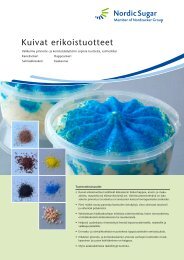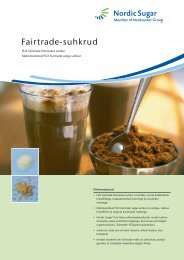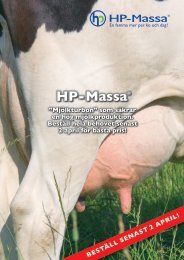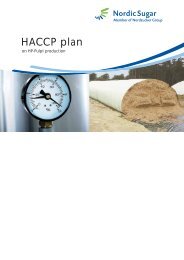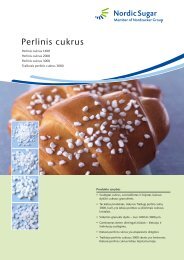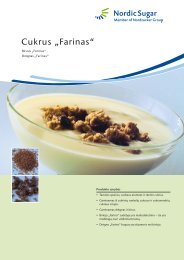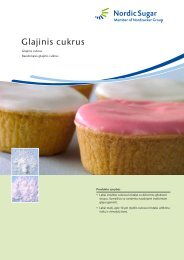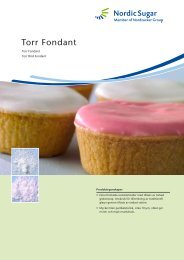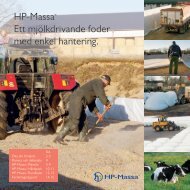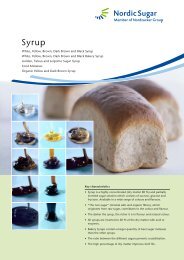HACCP plan
English - Nordic Sugar
English - Nordic Sugar
Create successful ePaper yourself
Turn your PDF publications into a flip-book with our unique Google optimized e-Paper software.
<strong>HACCP</strong> <strong>plan</strong><br />
on sugar beet pulp pellets production
Content<br />
1. Objectives<br />
1. Objectives<br />
2. The method<br />
3. Identification of<br />
CCPs and POAs<br />
4. Verification process<br />
5. Documentation<br />
The objectives with this booklet are to<br />
1. Explain and introduce Nordic<br />
Sugar’s <strong>HACCP</strong> work to customers<br />
and authorities<br />
2. Exchange general experiences with<br />
<strong>HACCP</strong> <strong>plan</strong>s throughout the<br />
organisation<br />
3. Create a common understanding<br />
of the <strong>HACCP</strong> method<br />
(calibration between factories)<br />
The current <strong>HACCP</strong> <strong>plan</strong> adresses<br />
product safety associated with<br />
production of pelletized dried sugar<br />
beet pulp (e.g Betfor®/Kosetter®).<br />
2. The method<br />
The <strong>HACCP</strong> <strong>plan</strong>s at Nordic Sugar are<br />
based on the GMP+ method (International<br />
Feed Ingredients Standard - IFIS)<br />
and the international food safety<br />
standard ISO 22000. We have taken<br />
every identified hazard in the whole<br />
process chain and evaluated them<br />
with regard to three basic steps in this<br />
method (the fourth step below is the<br />
verifi cation of the system). This<br />
procedure has clarified where the<br />
hazard should be controlled, how the<br />
hazard should be controlled and what<br />
verification procedures are necessary.<br />
1. Identification of chemical, physical,<br />
biological and allergenic hazards in<br />
each step of the process chain.<br />
2. In a risk assessment (2.2.) the<br />
severity and probability of each<br />
identified hazard are combined to<br />
determine the risk class and the type<br />
of control method necessary.<br />
3. By using the decision tree (2.3.) we<br />
have identified where the hazards<br />
should be controlled along the<br />
production chain. Based on the risk<br />
classes the decision tree is used to<br />
determine whether a given process<br />
step is a critical control point (CCP), a<br />
point of attention (POA/GMP) or just a<br />
periodic measure (PM).<br />
4. Apart from product specifications,<br />
process diagrams, risk analysis tables<br />
and summary tables, also activities<br />
towards verification of the <strong>HACCP</strong><br />
system are do cumented. These<br />
activities are e.g. audits, sampling and<br />
analysis of products, analysis of<br />
deviations and customer complaints.<br />
2.1. Severity<br />
and probability<br />
The severity of every possible hazard in<br />
the production chain has been<br />
estimated by the Nordic Sugar <strong>HACCP</strong><br />
Reference Group independent of the<br />
current production process. The<br />
probability of each hazard is very<br />
closely associated with the processes<br />
and the current process equipment.<br />
The probability has therefore been<br />
determined by the local <strong>HACCP</strong> group<br />
at the factory.<br />
- 2 -
2.2. Risk assessment matrix<br />
Severity<br />
Small Medium Great<br />
Great<br />
3<br />
POA<br />
Specific measures<br />
4<br />
CCP<br />
Critical measures<br />
4<br />
CCP<br />
Critical measures<br />
Probability*<br />
Medium<br />
2<br />
PM<br />
General measures<br />
3<br />
POA<br />
Specific measures<br />
4<br />
CCP<br />
Critical measures<br />
Small<br />
1<br />
No measures<br />
2<br />
PM<br />
General measures<br />
3<br />
POA<br />
Specific measures<br />
* Refers to the probability of the hazard being present in the end product e.g. at the moment of consumption.<br />
2.3. Decision tree<br />
Where will the hazard be controlled?<br />
Q1: Are there identified hazards present which have a harmful effect on the safety<br />
of the product and/or can the hazard exist or increase to unacceptable levels?<br />
Yes Q2, No stop!<br />
Q2: Which type of control measures are necessary according to the risk<br />
assessment?<br />
Critical measures (class 4) Q3, Specific measures (class 3) include<br />
measures as POA and in verification procedures,<br />
General measures (class 2) include measures as PM and in verification<br />
procedures or no measures (class 1) stop!<br />
Q3: Are the critical control measures referred to present?<br />
Yes Q4, No Modify the process or product and start again at Q1.<br />
Q4: Has this process step been specifically developed to eliminate the risk or<br />
reduce it to an acceptable level? No Q5, Yes CCP!<br />
Q5: Will the risk be eliminated in a subsequent process step or will it be reduced<br />
to an acceptable level? Yes Stop, No CCP!<br />
- 3 -
3. Identification of CCPs and POAs<br />
The way Nordic Sugar differs between a CCP and a POA<br />
CCP<br />
• A high risk step, which is likely to get out of control<br />
• Critical (and possible/applicable) control measures are needed in order to<br />
prevent, eliminate or reduce food & feed safety hazards to an acceptable level<br />
• If measures are out of control the corrective actions must include isolation of<br />
product batch, retesting, decontamination or destruction<br />
• The hazard is not eliminated or reduced to an acceptable level at a later stage<br />
in the process<br />
• If not in control the end product consitutes a serious health risk<br />
POA<br />
• A moderate risk step<br />
• Specific control measures essential to control the likelihood of introduction,<br />
contamination and/or proliferation of food & feed safety hazards<br />
• The hazard may be reduced at a later stage in the process<br />
• If measures are out of control the corrective actions include reevaluating<br />
procedure and/or checking equipment<br />
In total six POAs have been identified<br />
for the production of pelletized pulp at<br />
an arbitrary Nordic Sugar factory<br />
(see 3.1. Pelletized pulp(molassed)<br />
process). Whether any of our factories<br />
have actually confirmed the existence<br />
of the CCP and POAs, is however<br />
dependent on the characteristics of<br />
the factory i.e. equipment, specific<br />
production parameters, intended use<br />
of the product etc.<br />
- 4 -
3.1 Pelletized pulp (molassed) production process<br />
General process steps and description of POAs<br />
Beet reception<br />
Stone catchers<br />
Beet washing<br />
+ process aids<br />
Slicing &<br />
extraction<br />
Intermediate<br />
Storage<br />
POA<br />
Biological = growth of<br />
pathogenic microorganisms<br />
+Molasses,<br />
(+ Tops & tails from beets)<br />
Mixing<br />
w/flue gas (or steam)<br />
dry matter > 89%<br />
Drying<br />
POA<br />
Biological = later growth of<br />
pathogenic microorganisms due<br />
to incomplete drying<br />
Temp. > 70˚C,<br />
Pelletizing &<br />
cooling<br />
POA<br />
Biological = later growth of<br />
pathogenic microorganisms due<br />
to moisture formation at storage<br />
Storage<br />
POA<br />
Biological = formation of<br />
mycotoxins from moulds due<br />
to high moisture content<br />
Front loader<br />
Loading<br />
POA<br />
Physical: hard & sharp objects<br />
See description of hazards,<br />
control measures, action limits<br />
Transport<br />
To customer<br />
POA<br />
Biological: contamination with<br />
processed animal protein<br />
and corrective actions for these<br />
process steps in table 3.2. and 3.3.<br />
- 5 -
3.2. Hazard analysis table (risk evaluation)<br />
Processing step<br />
Potential Hazards<br />
introduced, controlled or enhanced at this step<br />
Control measures<br />
applied at this step to prevent/reduce/<br />
eliminate the hazard.<br />
1 Intermediate<br />
storage<br />
(B) Prolong storage time of pulp resulting in growth of<br />
pathogenic microorganisms & mycotoxin producing moulds<br />
Visual inspection and FIFO 2) principle at the<br />
storage area, should limit the maximum storage time<br />
2 Drying<br />
(B) Growth of pathogenic microorganisms and formation of<br />
mycotoxins from mould due to incomplete drying<br />
Right heating temperature and process flow<br />
3 Pelletizing &<br />
cooling<br />
(B) Growth of pathogenic microorganisms - and formation of<br />
mycotoxins from mould at storage - if temperature is too high<br />
(condensation)<br />
Cooling of pellets before storage<br />
4 Storage<br />
(B) Growth of pathogenic microorganisms and formation of<br />
mycotoxins from mould due to moisture formation during<br />
storage<br />
Discarding affected pellets<br />
5 Loading<br />
(P) Contamination with hard and sharp objects 3-25 mm<br />
Visual inspection of trucks and storage area/trucks<br />
6 Transport<br />
To customer<br />
(B) Contamination with processed animal protein (BSE)<br />
Contract with transporters and random sampling of<br />
trucks<br />
1) Refers to the questions in the Decision tree (see 2.3. Decision tree).<br />
B=Biological<br />
C=Chemical<br />
P=Physical<br />
SM=Specific measures<br />
2) FIFO = first in first out<br />
- 6 -
Is this step a critical control point?<br />
Evaluation of hazard<br />
Severity and probability in the<br />
risk assessment matrix gives<br />
the risk class<br />
Decision tree questions<br />
CCP/POA/PM Comm. / Ref<br />
1 / 2 / 3 / 4 / 5 1)<br />
Great × small = 3<br />
Yes / SM<br />
POA<br />
Intermediate storage is a POA for<br />
microbiological hazards<br />
Great × small = 3<br />
Yes / SM<br />
POA<br />
Drying is a POA<br />
for microbiological hazards<br />
Great × small = 3<br />
Yes / SM<br />
POA<br />
Cooling is a POA<br />
for microbiological hazards<br />
Great × small = 3<br />
Yes / SM<br />
POA<br />
Storage of pellets is a POA<br />
for microbiological hazards<br />
Medium × medium = 3<br />
Yes / SM<br />
POA<br />
Loading is a POA<br />
for physical hazards<br />
Great x small = 3<br />
Yes / SM<br />
POA<br />
Contract agreement and random samling of trucks<br />
is a POA for biological hazard (BSE)<br />
- 7 -
3.3 <strong>HACCP</strong> Summary table<br />
CCP<br />
Process<br />
Hazard<br />
Control<br />
Frequency<br />
or POA<br />
step<br />
to control<br />
Method<br />
1 POA<br />
Intermediate<br />
storage<br />
Growth of pathogenic microorganisms and<br />
mycotoxin formation<br />
Visual inspection and FIFO 1)<br />
principle at the pulp storage area<br />
Continuosly<br />
2 POA<br />
Drying<br />
Growth of pathogenic microorganisms &<br />
formation of mycotoxin due to moisture content<br />
Heating and flow control<br />
Continuosly<br />
of pulp and pellets<br />
3 POA<br />
Pelletizing &<br />
cooling<br />
Growth of pathogenic microorganisms &<br />
formation of mycotoxins if moisture content or<br />
Cooling of pellets<br />
Continuosly<br />
temperature is too high after cooling<br />
4 POA<br />
Storage<br />
Growth of pathogenic microorganisms &<br />
formation of mycotoxins due to high moisture<br />
content<br />
Visual inspection of pellets and<br />
discard of mould-affected pellets<br />
Weekly<br />
5 POA<br />
Loading<br />
Presence of hard & sharp<br />
objects 3 - 25 mm<br />
Visual inspection before loading<br />
of vehicles<br />
At loading<br />
Transport<br />
To customer<br />
6 POA 2) FIFO = first in first out<br />
Processed animal protein (BSE) contaminating<br />
pulp during transport<br />
Contract with transporters about no<br />
transports of risk materials and random<br />
verification of compliance<br />
Randomly at loading<br />
- 8 -
Action limit<br />
Corrective action<br />
- when action limit is exceeded<br />
Responsible<br />
Reference<br />
Target limit: Storage time < 3 days<br />
Action limit: Storage time > 3 days<br />
Discard of older pulp<br />
Head of<br />
storage<br />
Local instructions for activities<br />
covering this area<br />
Target limit: Dry matter > 89%, drying<br />
temperature > 550ºC<br />
Action limit: Dry matter < 89%, drying<br />
Evaluate product with low dry matter and/or<br />
poor heat treatment - discard if necessary<br />
Process<br />
operator<br />
Local instructions for activities<br />
covering this area<br />
temperature > 550ºC<br />
Target limit: temperature of pellets<br />
below instructions<br />
Action limit: temperature of pellets<br />
Evaluate product with poor cooling - discard if<br />
necessary<br />
Process<br />
operator<br />
Local instructions for activities<br />
covering this area<br />
above instructions<br />
Target limit: Visually mould-free pellets<br />
Action limit: Visual mouldy pellets<br />
Mould and affected pellets<br />
are discarded<br />
Storeman<br />
Local instructions for activities<br />
covering this area<br />
Target limit: No foreign objects<br />
Action limit: Presence of foreign objects<br />
Observed foreign objects are<br />
removed, and vehicles are returned<br />
Storeman<br />
Local instructions for activities<br />
covering this area<br />
for cleaning<br />
Target limit: Confirmation that no-risk materials has been<br />
transported<br />
Action limit: Transport of risk materials<br />
Vehicle is rejected<br />
Operator at<br />
weighing bridge<br />
Load instructions for activities<br />
covering this area<br />
- 9 -
4. Verification process<br />
Sustaining a high quality and secure<br />
<strong>HACCP</strong> system requires continuous<br />
evaluation and review of the system.<br />
A Nordic Sugar review of the risk<br />
analysis and verification of the <strong>HACCP</strong><br />
<strong>plan</strong>s consists of the following<br />
elements:<br />
• Trend analyses of monitoring of<br />
POAs and or CCPs e.g. how often<br />
do we identify broken sieves<br />
• Sampling and analysis of end<br />
products as a part of our<br />
quality program.<br />
• Evaluation of complaints and/or<br />
emergencies reported to<br />
Nordic Sugar.<br />
• Internal and external audits.<br />
Audits -with focus on e.g. hygiene and<br />
<strong>HACCP</strong> are performed by internal and<br />
external parties.<br />
These elements are used to verify the<br />
current <strong>HACCP</strong> <strong>plan</strong>s at the different<br />
production sites. The verification is<br />
done whenever necessary and at least<br />
once a year.<br />
- 10 -
5. Documentation<br />
In the description of our <strong>HACCP</strong><br />
system the following documents are<br />
included:<br />
• <strong>HACCP</strong> team documents<br />
(members and areas of expertise)<br />
• Flowcharts i.e. process diagrams<br />
• Hazard analysis tables<br />
• <strong>HACCP</strong> summary tables<br />
(comprising exclusively POAs<br />
and CCPs)<br />
These documents are handled in the<br />
document management system (DMS)<br />
for each factory. The product safety<br />
manager located at the production site<br />
supports the management and<br />
updates the documentation.<br />
Deviations from criteria set for CCPs/<br />
POAs are reported and registered in a<br />
Deviation Database and/or the<br />
Laboratory Information Management<br />
System (LIMS) or Production Information<br />
Management System (PIMS).<br />
Deviations identified at the factories<br />
(at e.g. audits) are reported and<br />
communicated in a Deviation<br />
Database. Customer complaints are<br />
registered in a similar database,<br />
”Sugar Complaints for sugar,<br />
Fibrex and animal feed products”.<br />
- 11 -
Printcentret langebrogade 1 v. 08 - OKT 2009<br />
Nordic Sugar A/S | Langebrogade 1 | PO Box 2100 | 1014 Copenhagen K | Denmark | +45 3266 25 00<br />
www.nordicsugar.com



